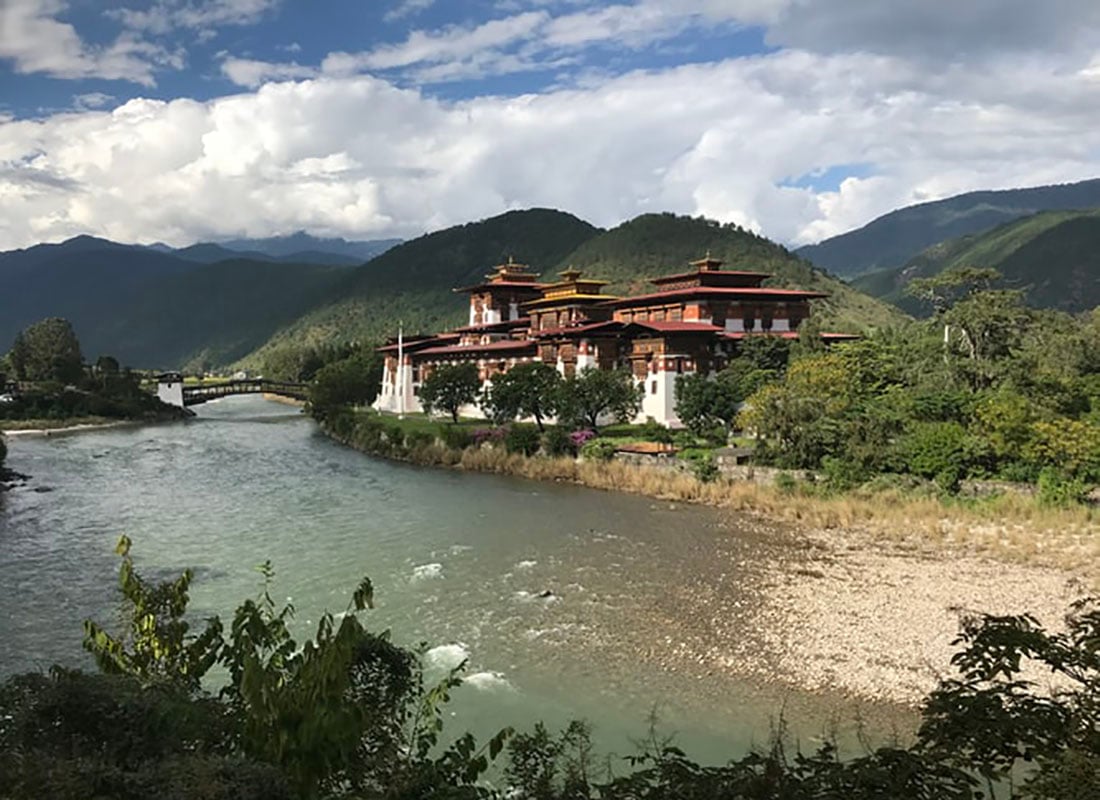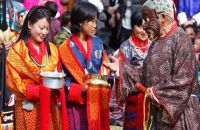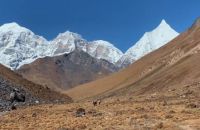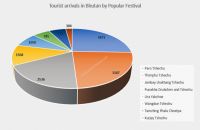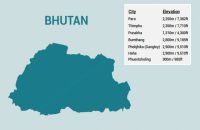Talk with our local travel specialist who can help organize your trip.
Top Incredible Places to Visit in Bhutan
Bhutan is one of the most popular holiday destinations in the Himalayan region. The country is dotted with traditional fortresses or dzongs, monasteries, lakhangs or Buddhist temples, picturesque villages, traditional wooden houses and lush green forests. Divided into dzongkhags or districts, the most popular cities visited by tourists include Thimphu, Punakha, Paro and Phobjika.
This small landlocked country was closed to foreign visitors till the early seventies when tourism was introduced in Bhutan. The country still restricts the number of tourists it allows inside the country by barring individual travel and charging a high tourism fee. This has been done to protect the fragile ecosystem of the country and to provide quality service to the tourists while improving the economic condition of the locals. A visit to Bhutan presents you with peaceful and tranquil moments spent amidst pristine surroundings. The exploration of the country’s cultural, religious and natural landmarks will open your eyes to the rich and unique Bhutanese culture and traditions.
Thimphu
Located in the central western part of the country, Thimphu is the the capital of Bhutan. It is the largest city in Bhutan and the world’s fifth highest capital at an altitude of 2334 metres. It is home to the nation’s royal family as well many important administrative offices and historical buildings. Thimphu is the economic and political heart of Bhutan and one of its few modern cities. The must-visit attractions in the capital city are:
The National Memorial Chorten
Built in 1974, the chorten lies in central Thimphu. This magnificent white stupa was built in memory of 3rd Duke Gyalpo (king of Bhutan), Jigme Dorje Wangchuk. It has three floors and each of these have four shrines. The ground floor holds a huge picture of the late king. The chorten is also dedicated to world peace. The National Memorial Chorten is the only stupa in Bhutan which does not hold the deceased remains of a religious leader or king. Among other festivals, the Moenlam Prayer Festival is held here presided over by the Je Khenpo or the chief Abbot. It is opened for public all 7 days of the week from 9 AM to 5 PM.
Tashichho Dzong
Tashichho Dzong or Thimphu Dzong is located on the northern part of the city, beside the Wang Chu River. This magnificent dzong was built over the remains of an existing structure in 1641 by Zhabdrung Ngawang Namgyal, the lama responsible for unifying Bhutan as a nation state. The dzong caught fire several times in the past and was renovated. The recent renovation took place in 1962. The Tashichho Dzong houses the secretariat, throne room of Bhutan’s royal family and offices of the King. The northern portion of the dzong houses a monastery and the summer residence of the Je Khenpo (chief abbot) and central monastic body.
Changankha Lakhang
Dating back to the 12th century AD, Changangkha Lakhang(temple) is one of the oldest Buddhist shrines in the city. This sacred structure stands on a ridge above Thimphu. Locals flock to this temple to seek blessings for their new born child from Tamdrin or the protector deity. They consult the resident astrologer for an auspicious name for the infant. The temple holds a magnificent statue of the thousand-armed Avalokiteshwara, prayer bells and ancient Buddhist manuscripts. Incense, money, local spirit, biscuits and snacks can be given as offerings to the deity.
Buddha Dordenma
Located atop a hill, the Buddha Dordenma is the largest statue of Lord Buddha in Bhutan. This magnificent bronze structure of the sitting Buddha is gilded in gold and holds 1,25,000 smaller statues of Lord Buddha inside. The throne of this huge statue serves as a massive meditation hall. Buddha Dordenma sits on a hill at the Kuenselphodrang Nature Park, overlooking the southern entrance of Thimphu. The statue was built in 2015 on the occasion of the 60th birth anniversary of Jigme Sinye wangchuk, the King of Bhutan. According to local belief, the statue fulfilled an ancient prophecy of a statue being built to bestow blessings, peace and happiness to the entire world.
Cheri Goemba
Cheri Goemba is Bhutan’s oldest monastery. Located in the northern part of Thimphu, the monastery lies in a forested hill that can be reached by walking on a steep trail for about 45 minutes from the highway. It was established by the founder of modern Bhutan, Zhabdrung Ngawal Namgyal, in 1620 as the home of Bhutan’s first official monk body. A silver chorten inside the goemba (monastery) holds the remains of Zhabdrung’s father, which was brought from Tibet. The protector deities of the monastery are Cheri and Tango. Surrounding the goemba are small monastic cells which serve as meditation retreats for visiting monks.
National Library of Bhutan
The National library was established in 1967 to preserve the ancient Tibetan and Dzongkha manuscripts. The library is built using traditional style of architecture. For people who are interested in Bhutanese history this is a treasure trove as the library has some of the oldest preserved documents on display. Sacred manuscripts of Buddhist as well as Bon religions, carved wooden blocks that were used for printing, letter dated 1783 from the Druk desi(ruler of Bhutan) to British surveyor Samuel Turner and the 2-metre tall copy of the world’s largest published book are some of the treasures of the National Library. One has to take off the shoes to enter the library.
National Institute for Zurig Chusum
The National Institute for Zurig Chusum or the painting school offers courses in Bhutan’s 13 traditional arts. Here students can learn traditional painting (thangkha or scroll painting as well as wood painting), sculpture, woodcarving, embroidery etc. Visitors are allowed to watch the students taking classes and creating their works of art. The completed works of the students are displayed at the institute’s showroom and are offered for sale.
National Textile Museum
The National Textile Museum or the Royal textile Academy is located near the National Library of Bhutan and has on display a stunning array of traditional as well as modern textiles. Bhutan has a rich history of weaving and here you will find interesting samples of traditional thagzo (weaving) and tshemzo (embroidery). The museum houses the traditional costumes worn by royalty in the ground floor. The upper floor showcases the traditional weaving techniques, different styles of ‘gho’ and ‘kira’, and traditional textiles. You can find local weavers weaving traditional textiles at the conservation centre. If you want to purchase the traditional textile, you can buy it from the museum shop.
Centenary Farmers’ Market
Thimphu’s Centenary Farmers’ Market opens only during the weekend. Farmers and traders from all over Bhutan congregate at this market to sell their products. Here you will find everything that is made in Bhutan – from handicraft items to exotic and organic food. The large market is divided into different sections. If you want to buy something, you need to head to that particular section where it is sold. Lively, buzzing with activity and filled with the aroma of dried fish, seasonal fruits, local yak cheese and incense, a trip to this local market is a treat for the senses. You get to interact with the local farmers and learn more about the local food culture. This is also a good place to get a good bargain on souvenir items. Must buy food items include local honey, dried yak cheese (churpi), oranges (if they are in season), red rice and dried mushrooms.
Motithang Takin Preserve
The Motithang Takin Preserve, which is home to Bhutan’s national animal, Takin, is located a few minutes’ drive from central Thimphu. The preserve was originally a zoo which was later closed down by the 4th King of Bhutan, as the king felt the ideals of Buddhism was opposed to caging of animals. After the zoo was abolished, the wild animals were freed and moved to their natural habitat, except for the takins. The takins took to the streets of Thimphu instead of moving to the forest. In order to keep them away from the city streets and preserve them, the Motithang Takin Preserve was established at the site of the former zoo. This unique looking creatures can be best viewed in the morning when they gather at the fences looking for food.
[More : 12 Days In Nepal And Bhutan - Where To Go And What To Do?]
Paro
Paro has the only international airport in Bhutan. Lying at an altitude of 2,200 metres, this scenic town lies on the banks of the Pa Chhu river and is surrounded by green hills and mountains. The ancient city is dotted with ancient dzongs(forts) and monasteries. Thimphu, the country’s capital lies very close to Paro, at a distance of 55 km. places worth exploring in paro include;
Taktsang Monastery (Tiger’s Nest)
The Tiger’s Nest or Taktsang Monastery is one of Bhutan’s iconic landmarks. Lying 12 kilometres from Paro, the monastery lies perched on a rocky cliff, on the side of a mountain. Padmasambhava or Guru Rinpoche is believed to have flown from Tibet on the back of a tigress and meditated here.
This is one of the most sacred Buddhist pilgrimage sites. One has to hike up a steep forested trail filled with colorful prayer flags to reach the monastery. The monastery has four main temples and dwellings used by the monks who live in the monastery. The buildings are connected by staircases carved in the rock. A large prayer wheel lies in the courtyard of the monastery. The monks turn this prayer wheel every morning at 4 AM, at the break of dawn. Photography is not allowed inside the monastery.
Rinpung Dzong
Rinpung Dzong also known is Paro Dzong is one of Paro’s major landmarks. Rinpung Dzong, which in Bhutanese means, Fortress on a Heap of Jewels’, is a fine example of Bhutanese traditional architecture. This ancient fort was established in 1644 by Zhabdrung Ngawang Namgyal on the remains of the Hungrel Dzong. Located on a steep hill, the fort was used as a point of defence to fight against hostile Tibetan forces.
The old fort now houses a monastery and administrative offices. Built without the use of nails, this magnificent building decorated with traditional wooden carvings and murals is a work of art. The fort houses several chapels, prayer halls, religious relics, paintings, including the massive thongdrel (giant thangka) with the embroidered imagae of Guru Rinpoche. The thongdrel is displayed on the last day of Paro Tshechhu, which is held at courtyard of the Paro Dzong.
Ta Dzong
Ta Dzong or the National Museum of Bhutan is located right above Rinpung Dzong. It was built in 1649 to protect the Rinpung Dzong. Built in the shape of a conch, this unique fort was renovated after suffering damages during the earthquake of 2011. The fort which houses Bhutan’s National Museum, has on display some of the country’s rare and valuable antiques and artifacts. It has a huge collection of thangkas(Buddhist scroll paintings), bronze statues, relics and sacred treasures discovered by the treasure finders.
Kyichu Lakhang
Kyichu Lakhang is one of the oldest Buddhist temples in Bhutan. The lakhang is believed to have been built by the Tibetan Emperor Songsten Gampo in the seventh century to subdue a demoness. According to local legend, Kyichu lakhng was built in a day on the right foot of the demoness. The temple was renovated and several buildings were added to the existing structure. Some of the treasured items inside the lakhang include a 5 metre high idol of Padmasambhava and the statue of Jowo Shakyamuni dating back to the seventh century.
Punakha
Located in west central Bhutan, Punakha is the second important city after Thimphu. The city served as the capital of Bhutan till 1955, when the capital was moved to Thimphu. Lying about 3 hours’ drive from the capital, Punakha still serves as the winter capital because of its warm climate. The fertile Punakha valley, situated on the banks of the Po Chu and Mo Chu rivers is the main producer of rice in Bhutan. The history of Punakha dzongkhang(district) dates back to 1577 AD and one can find here many historic monuments and monasteries. The places that are worth a visit in Punakha are:
Punakha Dzong
The beautiful Punakha Dzong lies at the confluence of the Po Chu and the Mo Chu Rivers. An excellent example of Bhutanese architecture, the dzong was built by Ngawang Namgyal in the 17th century. One has to cross a traditional wooden cantilever bridge built across the Mo Chu river to reach the fortress. This magnificent fortress is the official residence of the Bhutan’s central monk body.
The dzong houses precious relics of the southern Drukpa lineage of the Kagyu school of Tibetan Buddhism. Being the second largest and second oldest dzong in Bhutan, Punakha Dzong is one of this Himalayan nations cultural treasures. The coronation ceremony of all the Bhutanese kings has been held here.
The vibrant Punakha Dromche festival is celebrated on the grounds of this majestic fortress. Held on the first month of the Lunar calendar, energetic ‘Chams’ or masked dances are performed by the monks. The festival also sees the enactment of the Bhutanese-Tibetan war fought in the 17th century. Bhutan emerged as an independent nation after this war.
Chimi Lakhang Temple
Popularly known as the Fertility Temple, Chimi Lakhang Temple is frequented by childless couples with the hope that the patron saint of the temple, Drukpa Kuenley (Divine Madman) would bless them with a child. The temple was built in 1499 AD by Ngawang Choegyal in honor of Drukpa Kuenley who had successfully subdued a demoness using his magic thunderbolt.
Inside the temple, are the statues of Drukpa Kuenley and his dog, Sakyamuni Buddha, the thousand-armed Avalokiteshwara and Ngawang Choegyal, the founder of the temple. Devotees are blessed with the saint’s wooden phallus and iron archery set. The walls of the shrine are decorated with images depicting events from the saint’s life.
The lakhang lies in a scenic hill, surrounded by paddy fields. It takes around 20 minutes’ walk from the highway to reach this ancient temple. Traditional Bhutanese villages of Yoaka and Pangna lies close to the temple.
Khamsum Yulley Namgyal Chorten
The Khamsum Yulley Namgyal Chorten was built in 2004 by the Queen Mother of Bhutan to bring in peace and prosperity all over the world and to ward off negative forces. The chorten overlooking the Punakha valley was built according to laws set in Buddhist manuals. The four storied chorten is built in the Bhutanese traditional style. Local sculptors, painters and carpenters toiled for nine years to complete this stunning stupa.
The statue of Vajrakilaya, a wrathful Buddhist deity who destroys evil and demonic forces adorns the inside of the chorten. Statues of other protective deities are placed on the other two floors. On the top floor an idol of Lord Buddha looking southwards is placed. One can reach this chorten by taking a short drive of about 30 minutes from Punakha and walking up a trail past paddy fields to the chorten.
Recommended Read Top 10 Reasons To Visit Bhutan - A Mysterious Country In The Himalayas
Phobjikha Valley
Shaped like a bowl, the scenic Phobjikha Valley lies in central Bhutan. Surrounded by marshland and acres of forests and greenery, the valley is the winter nesting site of the endangered black-necked cranes. The valley borders the Jigme Singye Wangchuk national park and overlooks the Black Mountains. Phobjika or gangtey Valley is the favorite destination of bird watchers and nature lovers. Some of the highlights Phobjika Valley include:
Gangtey Goemba
Dating back to the seventeenth century, Gangtey Goemba is one of Bhutan’s largest Nyingmapa monastery. It is also the most important religious and cultural landmark in Phobjika Valley. The majestic monastery lies on a hill overlooking the valley.
The monastery was established by the grandson of Pema Lingpa, the discoverer of the divine treasures. Inside the monastery is a prayer hall, monks living quarters and meditation halls. The black-necked cranes circles the monastery three times while arriving and departing from the valley.
The Gangtey tshechu as well as the Black-necked Crane festival is held on the grounds of the goemba.
Black–Necked Crane Information Centre
The Black-Necked crane Information Centre offers information about the endangered black-necked cranes which flock to Phobjika Valley during the winter onths. The centre is run by the Royal Society for Protection of Nature. One can head to the centre’s observation room which has a high powered telescope to watch the birds (during winter). There is also a library and informative displays about the bio-diversity of the valley and surrounding areas.
Kumbhu Lakhang
Located on the north-east of the valley, the ancient temple of Kumbhu Lakhang dates back to the 17th century. The shrine is actually dedicated to a Bon deity Sipey Gyalpo. Built in the traditional style, the temple is divided into two floors. It houses a chapel and a meditation or retreat centre. The idol of the Medicine Buddha placed in the upper floor of the lakhang is said to heal the ailments of devotees who seek his blessings. Though one can visit this temple anytime of the year, it gets a bit tricky to reach this lakhang during rainy season as the dirt track becomes too muddy and slippery.
Haa Valley
Haa is Bhutan’s smallest district. Lying just about a couple of hours drive from Paro International Airport, the valley was out of bounds for visitors up until 2002. Surrounded by pristine forests and green meadows, Haa Valley is a must visit destination for nature buffs. The valley is home nomadic herders who still follow the old way of life. Secluded and nestled under the shadows of mountains, much of Haa Valley remains untouched by the negative influence of modern civilization.
The people of Haa Valley used to follow Bon and other animalistic religions before the arrival of Padmasambhava to the valley in the 8th century. His miraculous deeds led to the people to give up the animalistic rituals and practices and follow the teachings of Lord Buddha. Yet many still practice shamanistic rituals in the valley. Some of the cultural gems of Haa valley include the Lakhang Karpo (White Temple) and Lakhang Nagpo (Black temple), Haa Goemba, Jmatay Goemba etc. As most of the monasteries or goembas are located on hillsides or on a ridge, one can undertake day hikes to explore the monasteries as well as the pristine forests.
Wangdue Phodrang
Wangdue Phodrang in central Bhutan is the capital of Wangdue Phodrang dzongkhang (district). The town is home to the majestic Wangdue Phodrang dzong which was built by Zabdrung Ngawang Namgyal, the founder of the town and the dzong. The place is very popular with trekkers and hikers as most of the area falls under the ecologically rich Jigme Sinye Wangchuk National Park and jigme Dorje national Park. The inhabitants of Wangdue Phodrang speak a variety of regional languages – Dzonkha, Nyankha and Olekha.
Wangdue Phodrang dzong, which was built in the seventeenth century, is the most important of the town. The massive dzong is built on a ridge and resembles a sleeping elephant. It was prophesized that Zabdrung Ngawang Namgyal, would unify Bhutan if he could build the dzong by the ridge. The dzong has chapels, shrines and prayer hall. There are also government offices inside the dzong.
Bumthang
Bumthang which lies in north-central Bhutan, has the most number of historical sites and temples in the Himalayan country. The dzongkhang(district) is made up of four valleys – Choekhor Valley, Ura Valley, Tang Valley and Chumey Valley. The administrative centre of Bumthang is Jakar Dzong in Jakar. The most important historic sites in the district are Kurjey Lakhang, Jambey Lakhang, Ngang Lakhang, Tamshing Goemba , Kongchogsum Lakhang and Jakar Dzong.
Dochula Pass
Dochula pass is a high motorable pass that lies on the Punakha-Thimphu highway. Lying at an altitude of 3100m, the mountain pass offers panoramic views of the Himalayan range as well as the small hills surrounding the area. The pass is directed with 108 memorial chortens dedicated to fallen soldiers who lost their lives fighting insurgents on the Indo-Bhutan border. The beautifu chortens were built on the orders of Queen Mother Ashi Dorje Wangmo Wangchuk. The mountain pass also has a Buddhist temple, Druk Wangyal Lakhang which was built in honor of the fourth king of Bhutan. The mountain pass is the site of the annual Dochu La Wangyal Festival.
Chele La Pass
Chele La Pass, which lies on the highway connecting Haa Valley with Paro is the highest motorable mountain pass in Bhutan. Lying at an altitude of 3,988m, the pass offers outstanding views of Paro and Haa Valleys as well as the high mountain peaks of Jomolhari, Jichu Drake and other mountains. The pass is the starting pint of several ancient hiking trails that leads to ancient monasteries, nunneries, villages and towns. The ancient Kila Gompa, which is a nunnery can be accessed by hiking from the Chele La Pass. The buildings of the nunnery lies on a steep and rocky cliff. Filled with natural beauty, the pristine forest that covers the pass includes fields of rare white poppies which blooms only in this area in the country.
- Written by: Naba Raj Amgai
- Updated: Wednesday Nov 23, 2022

